Contents
- 1. User manual 1 of 5
- 2. User manual 2 of 5
- 3. User manual 3 of 5
- 4. User manual 4 of 5
- 5. User manual 5 of 5
User manual 2 of 5

iPod touch
User Guide
For iOS 8.3 Software
Apple Confidential
Contents
8 Chapter 1: iPod touch at a glance
8 iPod touch overview
8 Accessories
9 Multi-Touch screen
9 Buttons
11 Status icons
13 Chapter 2: Get started
13 Set up iPod touch
13 Connect to Wi-Fi
14 Connect to the Internet
14 Apple ID
14 iCloud
16 Set up other mail, contacts, and calendar accounts
16 Manage content on your iOS devices
16 Sync with iTunes
17 Connect iPod touch to your computer
18 Date and time
18 International settings
18 Your iPod touch name
18 View this user guide on iPod touch
18 Tips for using iOS 8
19 Chapter 3: Basics
19 Use apps
22 Continuity
23 Customize iPod touch
24 Type text
27 Dictate
28 Voice Control
29 Search
30 Control Center
30 AlertsandNoticationCenter
31 Sounds and silence
31 Do Not Disturb
32 Sharing
34 iCloud Drive
35 Transferles
35 AirPlay
35 AirPrint
36 Bluetooth devices
36 Restrictions
2
Apple Confidential
36 Privacy
37 Security
39 Charge and monitor the battery
40 Travel with iPod touch
41 Chapter 4: Siri
41 Make requests
42 Siri and apps
42 Tell Siri about yourself
42 Make corrections
42 Siri settings
43 Chapter 5: Messages
43 iMessage service
43 Send and receive messages
45 Manage conversations
45 Share photos, videos, your location, and more
46 Messages settings
47 Chapter 6: Mail
47 Write messages
48 Get a sneak peek
48 Finish a message later
49 See important messages
49 Attachments
50 Work with multiple messages
50 See and save addresses
50 Print messages
51 Mail settings
52 Chapter 7: Safari
52 Safari at a glance
53 Search the web
53 Browse the web
54 Keep bookmarks
55 Save a reading list for later
55 Shared links and subscriptions
56 Fill in forms
56 Avoid clutter with Reader
56 Privacy and security
57 Safari settings
58 Chapter 8: Music
58 Get music
58 iTunes Radio
60 Browse and play
61 Siri and Voice Control
61 iCloud and iTunes Match
62 Album Wall
62 Audiobooks
63 Playlists
Contents 3
Apple Confidential
63 Genius—made for you
64 Home Sharing
64 Music settings
65 Chapter 9: FaceTime
65 FaceTime at a glance
65 Make and answer calls
66 Manage calls
66 Settings
67 Chapter 10: Calendar
67 Calendar at a glance
68 Invitations
68 Use multiple calendars
69 Share iCloud calendars
69 Calendar settings
70 Chapter 11: Photos
70 View photos and videos
71 Organize photos and videos
72 My Photo Stream
73 iCloud Photo Library
73 iCloud Photo Sharing
75 Other ways to share photos and videos
75 Edit photos and trim videos
76 Print photos
76 Photos settings
77 Chapter 12: Camera
77 Camera at a glance
78 Take photos and videos
79 HDR
80 View, share, and print
80 Camera settings
81 Chapter 13: Weather
83 Chapter 14: Clock
83 Clock at a glance
84 Alarms and timers
85 Chapter 15: Maps
85 Find places
86 Get more info
86 Get directions
87 3D and Flyover
87 Maps settings
88 Chapter 16: Videos
88 Videos at a glance
89 Add videos to your library
89 Control playback
Contents 4
Apple Confidential
90 Videos settings
91 Chapter 17: Notes
91 Notes at a glance
92 Use notes in multiple accounts
93 Chapter 18: Reminders
93 Reminders at a glance
94 Scheduled reminders
94 Reminders settings
95 Chapter 19: Stocks
97 Chapter 20: Game Center
97 Game Center at a glance
98 Play games with friends
98 Game Center settings
99 Chapter 21: Newsstand
100 Chapter 22: iTunes Store
100 iTunes Store at a glance
100 Browse or search
101 Purchase, rent, or redeem
102 iTunes Store settings
103 Chapter 23: App Store
103 App Store at a glance
103 Find apps
104 Purchase, redeem, and download
105 App Store settings
106 Chapter 24: iBooks
106 Get books
106 Read a book
108 Organize books
108 Read PDFs
108 iBooks settings
110 Chapter 25: Health
110 Your health at a glance
110 Collecthealthandtnessdata
111 Sharehealthandtnessdata
112 Chapter 26: Passbook
112 Passbook at a glance
112 Passbook on the go
113 Passbook settings
Contents 5
Apple Confidential
114 Chapter 27: Calculator
115 Chapter 28: Podcasts
115 Podcasts at a glance
115 Get podcasts and episodes
117 Control playback
118 Organize your favorites into stations
118 Podcasts settings
119 Chapter 29: Voice Memos
119 Voice Memos at a glance
119 Record
120 Play it back
120 Move recordings to your computer
121 Chapter 30: Contacts
121 Contacts at a glance
122 Add contacts
122 Unify contacts
122 Contacts settings
124 Appendix A: Accessibility
124 Accessibility features
125 Accessibility Shortcut
125 VoiceOver
136 Zoom
137 Invert Colors and Grayscale
137 Speak Selection
137 Speak Screen
138 Speak Auto-text
138 Large, bold, and high-contrast text
138 Button Shapes
138 Reduce screen motion
138 On/oswitchlabels
138 Assignable tones
139 Video Descriptions
139 Hearing aids
140 Mono audio and balance
140 Subtitles and closed captions
140 Siri
140 Widescreen keyboards
140 Guided Access
141 Switch Control
145 AssistiveTouch
146 Voice Control
146 Accessibility in OS X
147 Appendix B: International keyboards
147 Use international keyboards
148 Special input methods
Contents 6
Apple Confidential
150 Appendix C: Safety, handling, and support
150 Important safety information
152 Important handling information
153 iPod touch Support site
154 Restart or reset iPod touch
154 Reset iPod touch settings
154 Get information about your iPod touch
155 Usage information
155 Disabled iPod touch
155 VPN settings
155 Prolessettings
156 Back up iPod touch
157 Update and restore iPod touch software
157 Sell or give away iPod touch
157 Learn more, service, and support
158 FCC compliance statement
158 Canadian regulatory statement
159 Disposal and recycling information
161 Apple and the environment
Contents 7
Apple Confidential
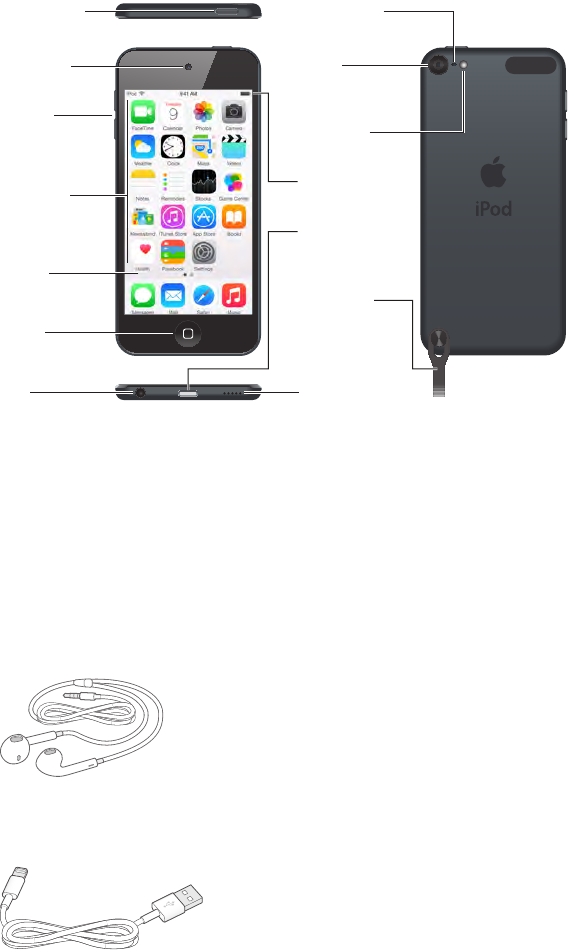
1
8
iPod touch overview
This guide describes the features of iOS 8 and iPod touch 5th generation.
iPod touch 5th generation
Microphone
Microphone
iSight
camera
iSight
camera
LED flash
LED flash
iPod touch
loop (some
models)
iPod touch
loop (some
models)
Sleep/Wake
button
Sleep/Wake
button
Volume
buttons
Volume
buttons
Headphones
port
Headphones
port
FaceTime
camera
FaceTime
camera
Home
button
Home
button
Multi-Touch
display
Multi-Touch
display
Speaker
Speaker
Lightning
connector
Lightning
connector
App icons
App icons
Status bar
Status bar
iPod touch apps and features may vary based on your location, language, and
modelofiPodtouch.Tondoutwhichfeaturesaresupportedinyourarea,see
www.apple.com/ios/feature-availability.
Accessories
The following accessories are included with iPod touch:
Apple EarPods. Use the Apple EarPods to listen to music, videos, audiobooks, podcasts,
and games.
Connecting cable. Using the Lightning to USB Cable, connect iPod touch to your computer to
sync and charge, or to the USB power adapter (sold separately) to charge.
iPod touch at a glance
Apple Confidential
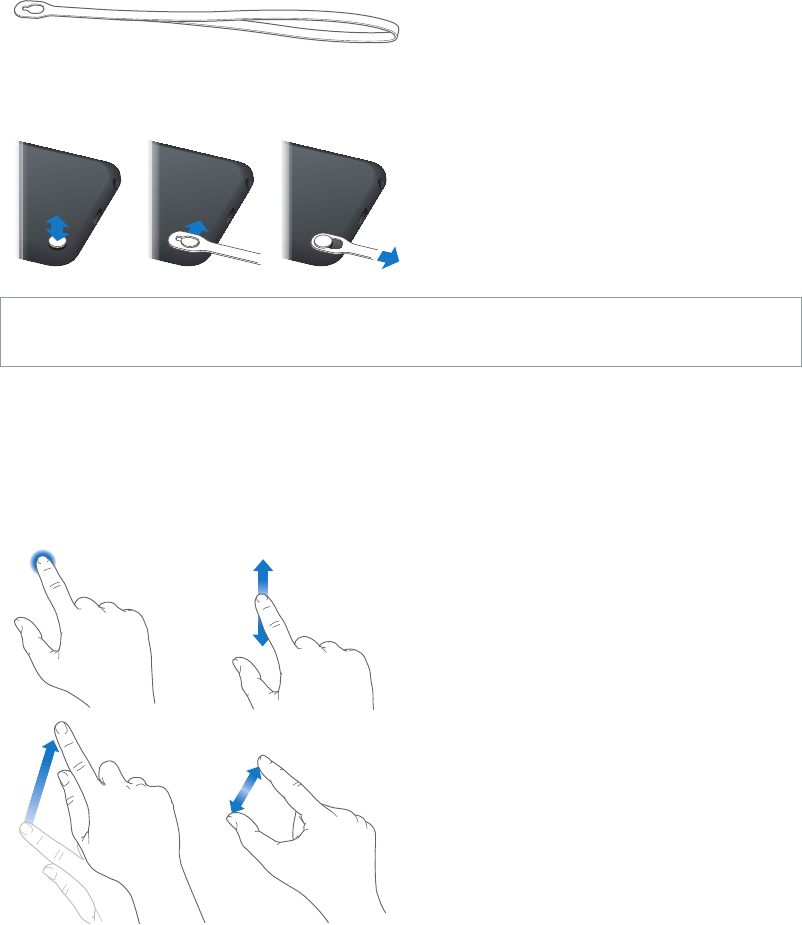
Chapter 1 iPod touch at a glance 9
iPod touch loop (included with 32 GB and 64 GB models and sold separately for 16 GB
models). Attach for an easy and secure way to carry iPod touch.
Press the button on the back of iPod touch to pop it up, slip the loop tab over the button, then
pull the loop to snap it in place.
WARNING: For important information about using the iPod touch loop, see Important safety
information on page 150.
Multi-Touch screen
The Multi-Touch screen displays a wealth of info, entertainment, and creativity, all at your
ngertips.Afewsimplegestures—tap,drag,swipe,andpinch—areallyouneedtoexploreand
use iPod touch apps.
Buttons
Most of the buttons you use with iPod touch are virtual ones on the touchscreen. A few physical
buttons control basic functions, such as turning on iPod touch or adjusting the volume.
Apple Confidential
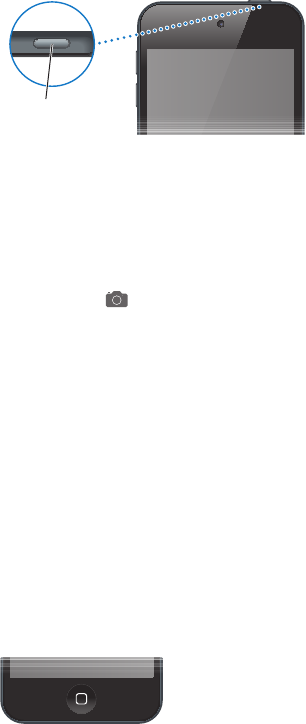
Chapter 1 iPod touch at a glance 10
Sleep/Wake button
When you’re not using iPod touch, press the Sleep/Wake button to lock iPod touch. Locking
iPod touch puts the display in sleep, saves the battery, and prevents anything from happening
if you touch the screen. You can still listen to music and adjust the volume using the buttons
onthesideofiPodtouch,andreceiveFaceTimecalls,textmessages,alarms,notications,and
other updates.
Sleep/Wake
button
Sleep/Wake
button
iPod touch locks automatically if you don’t touch the screen for a minute or so. To adjust the
timing, go to Settings > General > Auto-Lock.
Turn on iPod touch. Press and hold the Sleep/Wake button until the Apple logo appears.
•Open Camera when iPod touch is locked: Press the Sleep/Wake button or the Home button,
then drag up.
•Access the audio controls when iPod touch is locked: Swipe up from the bottom edge of the
screen to open Control Center.
Unlock iPod touch. Press the Sleep/Wake button or the Home button, then drag the slider.
Turn o iPod touch. Press and hold the Sleep/Wake button until the slider appears, then drag
the slider.
For additional security, you can require a passcode to unlock iPod touch. Go to Settings >
Passcode. See Use a passcode with data protection on page 37.
Home button
The Home button takes you to the Home screen and provides other convenient shortcuts. On
the Home screen, tap any app to open it.
See apps you’ve opened. Double-click the Home button. When iPod touch is unlocked, then
swipe left or right. See Start at home on page 19.
Use Siri or Voice Control. Press and hold the Home button. See Chapter 4, Siri, on page 41 and
Voice Control on page 28.
YoucanalsousetheHomebuttontoturnaccessibilityfeaturesonoro.SeeAccessibility
Shortcut on page 125.
Apple Confidential
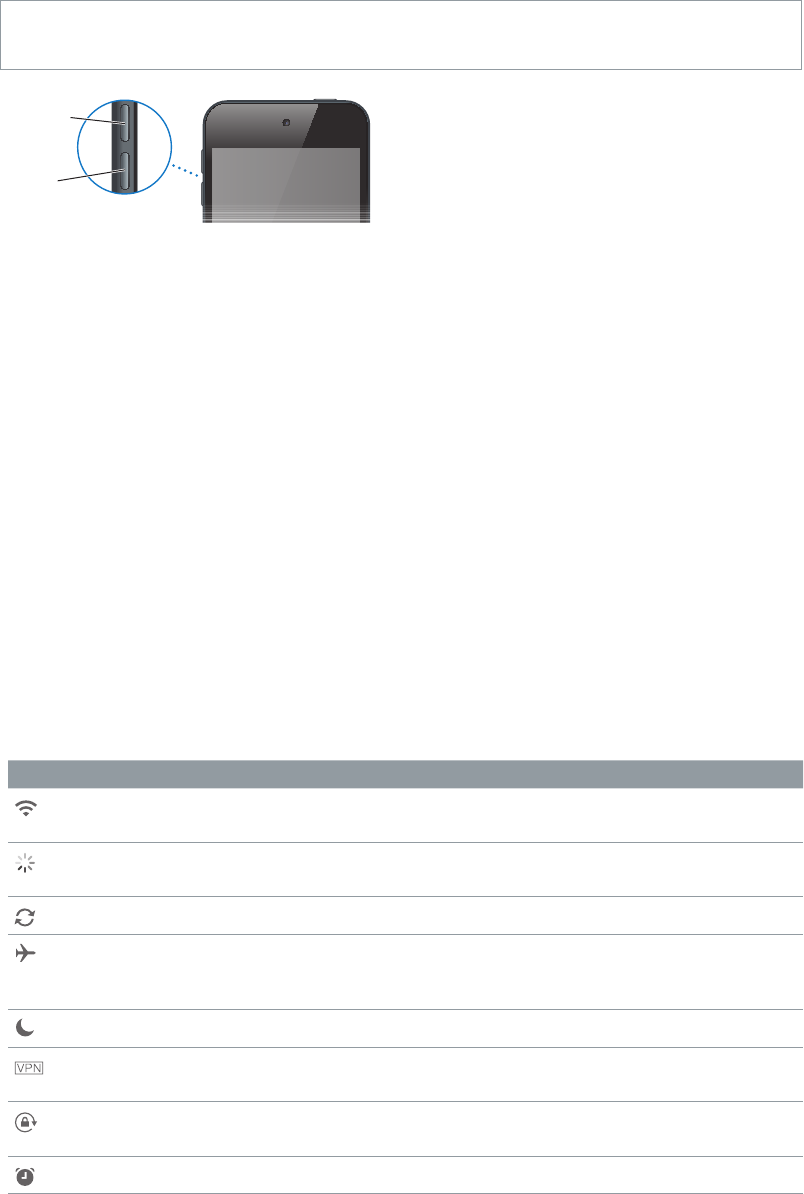
Chapter 1 iPod touch at a glance 11
Volume controls
When you listen to songs, movies, or other media, the buttons on the side of iPod touch adjust
theaudiovolume.Otherwise,thebuttonscontrolthevolumeforalertsandothersoundeects.
WARNING: For important information about avoiding hearing loss, see Important safety
information on page 150.
Volume
up
Volume
up
Volume
down
Volume
down
Lock the ringer and alerts volume. GotoSettings>Sounds,thenturnoChangewithButtons.
To limit the volume for music and videos, go to Settings > Music > Volume Limit.
Note: In some European Union (EU) countries, iPod touch may warn that you’re setting the
volume above the EU recommended level for hearing safety. To increase the volume beyond this
level,youmayneedtobrieyreleasethevolumecontrol.Tolimitthemaximumheadsetvolume
to this level, go to Settings > Music > Volume Limit. To prevent changes to the volume limit, go
to Settings > General > Restrictions.
Use Control Center to adjust the volume. When iPod touch is locked or when you’re using
another app, swipe up from the bottom edge of the screen to open Control Center.
Do Not Disturb, also available in Control Center, is an easy way to keep iPod touch silent. See Do
Not Disturb on page 31.
You can also use either volume button to take a picture or record a video. See Take photos and
videos on page 78.
Status icons
The icons in the status bar at the top of the screen give information about iPod touch:
Status icon What it means
Wi-Fi iPod touch is connected to the Internet over a Wi-Fi network. See
Connect to Wi-Fi on page 13.
Network activity Shows that there’s network activity. Some third-party apps may also
use this icon to indicate an active process.
Syncing iPod touch is syncing with iTunes. See Sync with iTunes on page 16.
Airplane mode Airplane mode is on—you can't access the Internet or use
Bluetooth® devices. Non-wireless features are available. See Travel
with iPod touch on page 40.
Do Not Disturb “Do Not Disturb” is turned on. See Do Not Disturb on page 31.
VPN You’re connected to a network using VPN. See VPN settings on
page 155.
Portrait orientation
lock
The iPod touch screen is locked in portrait orientation. See Change
the screen orientation on page 21.
Alarm An alarm is set. See Alarms and timers on page 84.
Apple Confidential

Chapter 1 iPod touch at a glance 12
Status icon What it means
Location Services An item is using Location Services. See Privacy on page 36.
Bluetooth Blue or white icon: Bluetooth is on and paired with a device, such as
a headset.
Gray icon: Bluetooth is on. If paired with a device, the device may be
outofrangeorturnedo.
No icon: Bluetoothisturnedo.
See Bluetooth devices on page 36.
Bluetooth battery Shows the battery level of a supported paired Bluetooth device.
Battery Shows the iPod touch battery level or charging status. See Charge
and monitor the battery on page 39.
Apple Confidential

2
13
Set up iPod touch
·WARNING: To avoid injury, read Important safety information on page 150 before using
iPod touch.
With only a Wi-Fi connection, you can easily set up iPod touch. You can also set up iPod touch
by connecting it to a computer and using iTunes (see Connect iPod touch to your computer on
page 17).
Set up iPod touch. Turn on iPod touch, then follow the Setup Assistant.
The Setup Assistant steps you through the setup process, including:
•Connecting to a Wi-Fi network
•Signing in with or creating a free Apple ID (needed for many features, including iCloud,
FaceTime, the iTunes Store, and the App Store)
•Entering a passcode
•Setting up iCloud and iCloud Keychain
•Turning on recommended features such as Location Services
You can also restore from an iCloud or iTunes backup during setup. See Back up iPod touch on
page 156.
Note: Find My iPod touch is turned on when you sign in to iCloud. Activation Lock is engaged
to help prevent anyone else from setting up your iPod touch, even if it is completely restored.
Before you sell or give away your iPod touch, you should reset it to erase your personal content
andturnoActivationLock.SeeSell or give away iPod touch on page 157.
Connect to Wi-Fi
If appears at the top of the screen, you’re connected to a Wi-Fi network. iPod touch
reconnects anytime you return to the same location.
Congure Wi-Fi. Go to Settings > Wi-Fi.
•Choose a network: Tap one of the listed networks, then enter the password, if asked.
•Ask to join networks: Turn Ask to Join Networks on to be prompted when a Wi-Fi network
is available. Otherwise, you must manually join a network when a previously used network
isn’t available.
•Join a closed Wi-Fi network: Tap Other, then enter the name of the closed network. You need to
know the network name, security type, and password.
•Adjust the settings for a Wi-Fi network: Tap next to a network. You can set an HTTP proxy,
denestaticnetworksettings,turnonBootP,orrenewthesettingsprovidedbyaDHCPserver.
•Forget a network: Tap next to a network you’ve joined before, then tap Forget this Network.
Get started
Apple Confidential

Chapter 2 Get started 14
Set up your own Wi-Fi network. IfyouhaveanunconguredAirPortbasestationturnedonand
within range, you can use iPod touch to set it up. Go to Settings > Wi-Fi and look for Set up an
AirPort base station. Tap your base station and the Setup Assistant will do the rest.
Manage an AirPort network. If iPod touch is connected to an AirPort base station, go to
Settings > Wi-Fi, tap next to the network name, then tap Manage this Network. If you haven’t
yet downloaded AirPort Utility, tap OK to open the App Store, then download it.
Connect to the Internet
iPod touch connects to the Internet by joining Wi-Fi networks. When joined to a Wi-Fi network
that is connected to the Internet, iPod touch connects to the Internet automatically whenever
you use Mail, Safari, FaceTime, Game Center, Stocks, Maps, Weather, the iTunes Store, or the
App Store.
Apple ID
Your Apple ID is the account you use for just about everything you do with Apple, including
storing your content in iCloud, downloading apps from the App Store, buying music, movies, and
TV shows from the iTunes Store, and purchasing books from the iBooks Store.
IfyoualreadyhaveanAppleID,useitwhenyourstsetupiPodtouch,andwheneveryouneed
to sign in to use an Apple service. If you don’t already have an Apple ID, you can create one
whenever you’re asked to sign in. You only need one Apple ID for everything you do with Apple.
For more information, see appleid.apple.com.
iCloud
iCloudoersfreemail,contacts,calendar,andotherfeaturesthatyoucansetupsimplyby
signing in to iCloud with your Apple ID, then making sure that the features you want to use are
turned on.
Set up iCloud. Go to Settings > iCloud. Create an Apple ID if needed, or use your existing one.
iCloud stores your photos and videos, documents, music, calendars, contacts, and more. Content
stored in iCloud is pushed wirelessly to your other iOS devices and computers signed into iCloud
with the same Apple ID.
iCloud is available on devices with iOS 5 or later, on Mac computers with OS X Lion v10.7.5 or
later, and on PCs with iCloud for Windows 4.0 (Windows 7 or Windows 8 is required).
Note: iCloud may not be available in all areas, and iCloud features may vary by area. For more
information, go to www.apple.com/icloud.
iCloud features include:
•Music, Movies, TV Shows, Apps, and Books: Automatically get iTunes purchases on all your
devices set up with iCloud, or download previous iTunes music and TV show purchases for
free, anytime. With an iTunes Match subscription, all your music, including music you’ve
imported from CDs or purchased somewhere other than the iTunes Store, can also be stored
in iCloud and played on demand. See iCloud and iTunes Match on page 61. Download previous
App Store and iBooks Store purchases to iPod touch for free, anytime.
Apple Confidential
Chapter 2 Get started 15
•Photos: Use iCloud Photo Library beta to store all your photos and videos in iCloud, and access
them from any iOS 8 device using the same Apple ID. Use iCloud Photo Sharing to share
photos and videos with just the people you choose, and let them add photos, videos, and
comments. See iCloud Photo Library on page 73. See iCloud Photo Sharing on page 73.
•Family Sharing: Up to six family members can share their purchases from the iTunes Store,
App Store, and iBooks Store. Pay for family purchases with the same credit card and approve
kids’ spending right from a parent’s device. Plus, share photos, a family calendar, and more. See
Family Sharing on page 32.
•iCloud Drive: Safely store your presentations, spreadsheets, PDFs, images, and other documents
in iCloud, and access them from your iPod touch, iPhone, iPad, Mac, or PC. See About iCloud
Drive on page 34.
•Documents in the Cloud: For iCloud-enabled apps, keep documents and app data up to date
across all your devices set up with iCloud.
•Mail, Contacts, Calendars: Keep your mail, contacts, calendars, notes, and reminders up to date
across all your devices. If you use iCloud, don’t also use iTunes to sync your contacts, calendars,
and bookmarks to iPod touch.
•Safari Tabs: See the tabs you have open on your other iOS devices or OS X computers. See
Browse the web on page 53.
•Backup: Back up iPod touch to iCloud automatically when connected to power and Wi-Fi.
iCloud data and backups sent over the Internet are encrypted. See Back up iPod touch on
page 156.
•Find My iPod: Locate your iPod touch on a map, display a message, play a sound, lock the
screen, or remotely wipe your iPod touch data. Find My iPod includes Activation Lock, which
requiresyourAppleIDandpasswordinordertoturnoFindMyiPodoreraseyourdevice.
Your Apple ID and password are also required before anyone can activate your iPod touch. See
Find My iPod touch on page 39.
•Find My Friends: Share your location with people who are important to you. Download the free
app from the App Store.
•iCloud Keychain: Keep your passwords and credit card information up to date across all your
designated devices. See iCloud Keychain on page 38.
With iCloud, you get a free mail account and 5 GB of storage for your mail, documents, photos,
and backups. Your purchased music, apps, TV shows, and books don’t count against your
available space.
Upgrade your iCloud storage. Go to Settings > iCloud > Storage, then tap Change Storage Plan.
For information about upgrading your iCloud storage, go to help.apple.com/icloud.
View and download previous purchases, or get purchases shared by your family.
•iTunes Store purchases: You can access your purchased songs and videos in the Music and
Videos apps. Or, in the iTunes Store, tap More, then tap Purchased.
•App Store purchases: Go to the App Store, tap Updates, then tap Purchased.
•iBooks Store purchases: Go to iBooks, tap Store, then tap Purchased.
Turn on Automatic Downloads for music, apps, or books. Go to Settings > iTunes & App Store.
For more information about iCloud, go to www.apple.com/icloud. For support information, go to
www.apple.com/support/icloud.
Apple Confidential
Chapter 2 Get started 16
Set up other mail, contacts, and calendar accounts
iPod touch works with Microsoft Exchange, and many of the most popular Internet-based mail,
contacts, and calendar service providers.
Set up an account. Go to Settings > Mail, Contacts, Calendars > Add Account.
You can add contacts using an LDAP or CardDAV account if your company or organization
supports it. See Add contacts on page 122.
You can add calendars using a CalDAV calendar account, and you can subscribe to iCalendar (.ics)
calendars or import them from Mail. See Use multiple calendars on page 68.
Manage content on your iOS devices
YoucantransferinformationandlesbetweenyouriOSdevicesandcomputers,usingiCloud
or iTunes.
•iCloud stores your photos and videos, documents, music, calendars, contacts, and more. It all
gets pushed wirelessly to your other iOS devices and computers, keeping everything up to
date. See iCloud on page 14.
•iTunes syncs music, videos, photos, and more between your computer and iPod touch.
Changes you make on one device are copied to the other when you sync. You can also use
iTunestosynclesanddocuments.SeeSync with iTunes, next.
You can use iCloud or iTunes, or both, depending on your needs. For example, you can use
iCloud to automatically keep your contacts and calendars up to date on all your devices, and use
iTunes to sync music from your computer to iPod touch.
Important: To avoid duplicates, keep contacts, calendars, and notes in sync using iCloud or
iTunes, but not both.
You can also manually manage content from iTunes, in the device’s Summary pane. This lets you
add songs and videos, by choosing a song, video, or playlist from your iTunes library and then
dragging it to your iPod touch in iTunes. This is useful if your iTunes library contains more items
thancantonyourdevice.
Note: If you’re using iTunes Match, you can manually manage only video.
Sync with iTunes
Syncing with iTunes copies information from your computer to iPod touch, and vice versa. You
can sync by connecting iPod touch to your computer, or you can set up iTunes to sync wirelessly
with Wi-Fi. You can set iTunes to sync music, videos, apps, photos, and more. For help syncing
iPod touch, open iTunes on your computer, choose Help > iTunes Help, then select Sync your
iPod, iPhone, or iPad. iTunes is available at www.itunes.com/download.
Set up wireless syncing. Connect iPod touch to your computer. Then in iTunes on your computer,
select your iPod touch, click Summary, and select Sync with this iPod over Wi-Fi.
If Wi-Fi syncing is turned on, iPod touch syncs when it’s connected to a power source, both
iPod touch and your computer are on and connected to the same wireless network, and iTunes is
open on your computer.
Apple Confidential

Chapter 2 Get started 17
Tips for syncing with iTunes on your computer
ConnectiPodtouchtoyourcomputer,selectitiniTunes,thensetoptionsinthedierentpanes.
•If iPod touch doesn’t appear in iTunes, make sure you’re using the latest version of iTunes,
check that the included Lightning to USB cable is correctly connected, then try restarting
your computer.
•In the Summary pane, you can set iTunes to automatically sync iPod touch when it’s attached
to your computer. To temporarily override this setting, hold down Command and Option (Mac)
or Shift and Control (PC) until you see iPod touch appear in the iTunes window.
•In the Summary pane, select “Encrypt iPod backup” if you want to encrypt the information
stored on your computer when iTunes makes a backup. Encrypted backups are indicated by
a lock icon , and a password is required to restore the backup. If you don’t select this option,
other passwords (such as those for mail accounts) aren’t included in the backup, and you’ll
have to reenter them if you use the backup to restore iPod touch.
•In the Info pane, when you sync mail accounts, only the settings are transferred from your
computertoiPodtouch.ChangesyoumaketoamailaccountoniPodtouchdon’taectthe
account on your computer.
•In the Info pane, click Advanced to select options that let you replace the information on
iPod touch with the information from your computer during the next sync.
•In the Music pane, you can sync music using your playlists.
•In the Photos pane, you can sync photos and videos from a supported app or folder on
your computer.
•If you use iCloud to store your contacts, calendars, and bookmarks, don’t also sync them to
iPod touch using iTunes.
•If you turn on iCloud Photo Library beta, you can’t use iTunes to sync photos and videos to
iPod touch.
Connect iPod touch to your computer
Connecting iPod touch to your computer lets you sync content from your computer using
iTunes. See Sync with iTunes, above.
To use iPod touch with your computer, you need:
•An Internet connection for your computer (broadband is recommended)
•A Mac or a PC with a USB 2.0 or 3.0 port and one of the following operating systems:
•OS X version 10.6.8 or later
•Windows 8, Windows 7, Windows Vista, or Windows XP Home or Professional with Service
Pack 3 or later
Connect iPod touch to your computer. Use the Lightning to USB Cable provided with
iPod touch.
Apple Confidential

Chapter 2 Get started 18
Date and time
The date and time are usually set for you based on your location—take a look at the Lock screen
to see if they’re correct.
Set whether iPod touch updates the date and time automatically. Go to Settings > General
>Date&Time,thenturnSetAutomaticallyonoro.IfyousetiPodtouchtoupdatethetime
automatically, it gets the correct time based on your Wi-Fi connection. In some cases, iPod touch
may not be able to automatically determine the local time.
Set the date and time manually. GotoSettings>General>Date&Time,thenturno
Set Automatically.
Set whether iPod touch shows 24-hour time or 12-hour time. Go to Settings > General > Date &
Time,thenturn24-HourTimeonoro.(24-HourTimemaynotbeavailableinallareas.)
International settings
Go to Settings > General > Language & Region to set the following:
•The language for iPod touch
•The preferred language order for apps and websites
•The region format
•The calendar format
•Advanced settings for dates, times, and numbers
To add a keyboard for another language, go to Settings > General > Keyboard > Keyboards. For
more information, see Use international keyboards on page 147.
Your iPod touch name
The name of your iPod touch is used by both iTunes and iCloud.
Change the name of your iPod touch. Go to Settings > General > About > Name.
View this user guide on iPod touch
You can view the iPod touch User Guide on iPod touch in Safari, and in the iBooks app.
View the user guide in Safari. Tap , then tap the iPod touch User Guide bookmark. (If you
don’t see a bookmark, go to help.apple.com/ipod-touch.)
•Add an icon for the user guide to the Home screen: Tap , then tap Add to Home Screen.
•View the user guide in a dierent language: Tap Change Language at the bottom of the
home page.
View the user guide in iBooks. Open iBooks, then search for “iPod touch user” in the
iBooks Store.
For more information about iBooks, see Chapter 24, iBooks, on page 106.
Tips for using iOS 8
The Tips app helps you get the most from iPod touch.
Get Tips. Open the Tips app. New tips are added weekly.
Get notied when new tips arrive. GotoSettings>Notications>Tips.
Apple Confidential
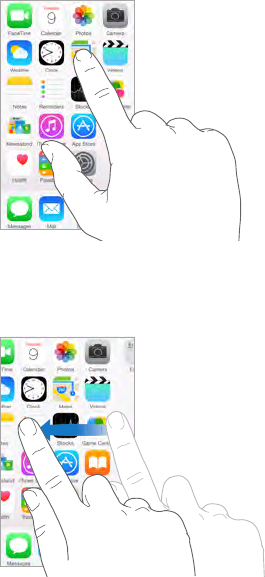
3
19
Use apps
All the apps that come with iPod touch—as well as the apps you download from the
App Store—are on the Home screen.
Start at home
Tap an app to open it.
Press the Home button anytime to return to the Home screen. Swipe left or right to see
other screens.
Multitasking
iPod touch helps you manage several tasks at the same time.
Basics
Apple Confidential

Chapter 3 Basics 20
View contacts and open apps. Double-click the Home button to reveal the multitasking
screen. Swipe left or right to see more. To switch to another app, tap it. To connect with a
recent or favorite contact, tap the contact’s picture or name, then tap your preferred method
of communication.
Close an app. If an app isn’t working properly, you can force it to quit. Drag the app up from the
multitasking display. Then try opening the app again.
Ifyouhavelotsofapps,youcanuseSpotlighttondandopenthem.Dragdownthecenterof
theHomescreentogetthesearcheld.SeeSearch apps on page 29.
Look around
Drag a list up or down to see more. Swipe to scroll quickly; touch the screen to stop it. Some lists
have an index—tap a letter to jump ahead.
Drag a photo, map, or webpage in any direction to see more.
To quickly jump to the top of a page, tap the status bar at the top of the screen.
Get a closer look
Pinch open on a photo, webpage, or map for a close-up—then pinch closed to zoom back out. In
Photos, keep pinching to see the collection or album the photo’s in.
Apple Confidential
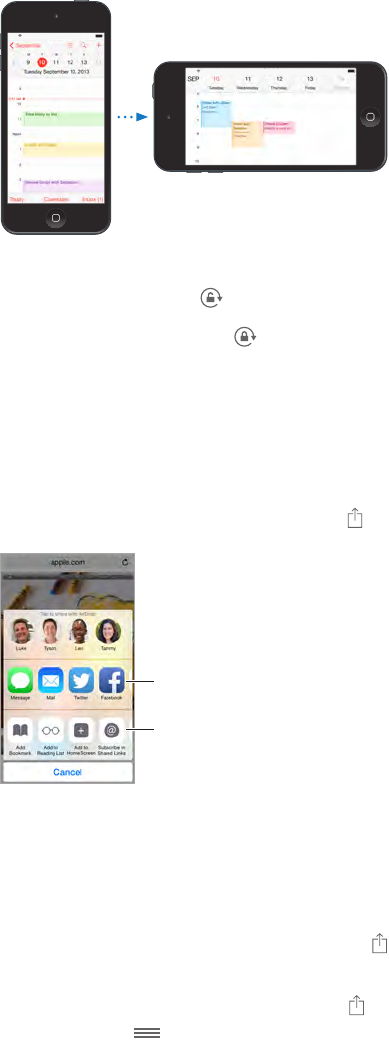
Chapter 3 Basics 21
Or double-tap a photo or webpage to zoom in, and double-tap again to zoom out. In Maps,
double-taptozoominandtaponcewithtwongerstozoomout.
Change the screen orientation
ManyappsgiveyouadierentviewwhenyourotateiPodtouch.
9:41 AMiPod
100%
9:41 AMiPod
100%
To lock the screen in portrait orientation, swipe up from the bottom edge of the screen to open
Control Center, then tap .
The portrait orientation lock icon appears in the status bar when the screen orientation
is locked.
App extensions
Some apps let you extend the functionality of your apps on iPod touch. An app extension may
appearasasharingoption,actionoption,awidgetinNoticationCenter,aleprovider,ora
custom keyboard. For example, if you download Pinterest to iPod touch, Pinterest becomes
another option for sharing when you click .
Sharing options
Sharing options
Action options
Action options
App extensions can also help you edit a photo or video in your Photos app. For example, you can
downloadaphoto-relatedappthatletsyouapplylterstophotosfromyourPhotosapp.
Install app extensions. Download the app from the App Store, then open the app and follow the
onscreen instructions.
Turn sharing or action options on or o. Tap , then tap More (drag options to the left if
necessary).Turnothird-partysharingoractionoptions(theyareonbydefault).
Organize sharing and action options. Tap , then tap More (drag icons to the left if necessary).
Touch and drag to rearrange your options.
FormoreinformationaboutNoticationCenterwidgets,seeNoticationCenter on page 30. For
more information about Sharing options, see Share from apps on page 32.
Apple Confidential
Chapter 3 Basics 22
Continuity
About Continuity features
Continuity features connect iPod touch with your iPhone, iPad, and Mac so they can work
together as one. You can start an email or document on iPod touch, for example, then pick up
whereyouleftoonyouriPadorMac.OrletiPodtouchuseiPhonetomakephonecallsorsend
SMS or MMS text messages.
Continuity features require iOS 8 or OS X Yosemite, and work with iPhone 5 or later, iPod touch
(5th generation) or later, iPad (4th generation) or later, and supported Mac computers. For more
information, see support.apple.com/kb/HT6337.
Hando
Pickupononedevicewhereyouleftoonanother.YoucanuseHandowithMail,Safari,Pages,
Numbers, Keynote, Maps, Messages, Reminders, Calendar, Contacts, and even some third-party
apps.ForHandotowork,yourdevicesmustbesignedintoiCloudusingthesameAppleID,and
they must be within Bluetooth range of one another (about 33 feet or 10 meters).
Switch devices. Swipe up from the bottom-left edge of the Lock screen (where you see the app’s
activity icon), or go to the multitasking screen, then tap the app. On your Mac, open the app you
were using on your iOS device.
Disable Hando on your devices. GotoSettings>General>Hando&SuggestedApps.
Disable Hando on your Mac. GotoSystemPreferences>General,thenturnoAllowHando
between this Mac and your devices set up with iCloud.
Phone calls
If your iPhone (with iOS 8) is nearby, you can make and receive phone calls on your other iOS
devices and Mac computers. All devices must be on the same Wi-Fi network, and signed into
FaceTime and iCloud using the same Apple ID. (On iPhone, make sure Allow Wi-Fi Calls is turned
oatSettings>Phone>Wi-FiCalls.)
Make a phone call on iPod touch. Tap a phone number in Contacts, Calendar, or Safari. You can
also tap a recent contact in the multitasking screen.
Disable iPhone Cellular Calls. OnyouriPhone,gotoSettings>FaceTime,thenturnoiPhone
Cellular Calls.
Messages
If your iPhone (with iOS 8) is signed into iMessage using the same Apple ID as your iPod touch,
you can also send and receive SMS and MMS messages on your iPod touch. Charges may apply
to the text messaging service for your iPhone.
Instant Hotspot
You can use Instant Hotspot on your iPhone (with iOS 8) or iPad (cellular models with iOS 8) to
provide Internet access to your other iOS devices and Mac computers that are signed into iCloud
using the same Apple ID. Instant Hotspot uses your iPhone or iPad Personal Hotspot, without you
having to enter a password or even turn on Personal Hotspot.
Use Instant Hotspot. Go to Settings > Wi-Fi on your iPod touch, then simply choose your iPhone
or iPad network under Personal Hotspots. On your Mac, choose your iPhone or iPad network
from your Wi-Fi settings.
When you’re not using using the hotspot, your devices disconnect to save battery life.
Apple Confidential
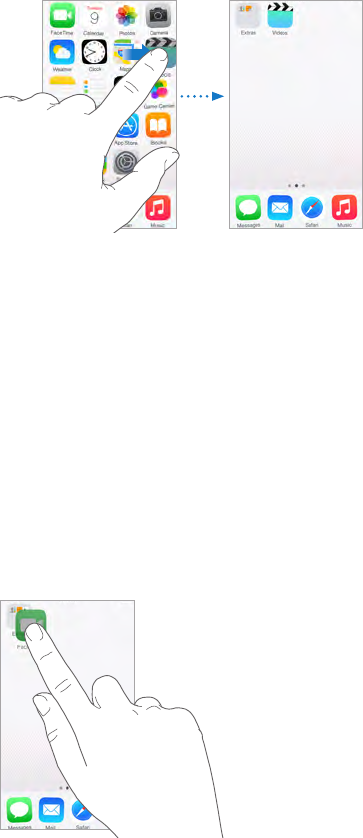
Chapter 3 Basics 23
Note: This feature may not be available with all carriers. Additional fees may apply. Contact your
carrier for more information.
Customize iPod touch
Arrange your apps
Arrange apps. Touch and hold any app on the Home screen until it jiggles, then drag apps
around.DraganapptotheedgeofthescreentomoveittoadierentHomescreen,ortothe
Dock at the bottom of the screen. Press the Home button to save your arrangement.
Create a new Home screen. While arranging apps, drag an app to the right edge of the last
Home screen. The dots above the Dock show how many Home screens you have, and which one
you’re viewing.
You can also customize the Home screen using iTunes when iPod touch is connected to your
computer. In iTunes, select iPod touch, then click Apps.
Start over. Go to Settings > General > Reset, then tap Reset Home Screen Layout to return the
Home screen and apps to their original layout. Folders are removed and the original wallpaper
is restored.
Organize with folders
Create a folder. While arranging apps, drag one app onto another. Tap the name of the folder to
renameit.Dragappstoaddorremovethem.PresstheHomebuttonwhenyounish.
You can have multiple pages of apps in a folder.
Delete a folder. Drag out all the apps—the folder is deleted automatically.
Change the wallpaper
Wallpaper settings let you set an image or photo as wallpaper for the Lock screen or Home
screen. You can choose from dynamic and still images.
Apple Confidential

Chapter 3 Basics 24
Change the wallpaper. Go to Settings > Wallpaper > Choose a New Wallpaper.
When choosing an image for new wallpaper, the Perspective Zoom button determines whether
your selected wallpaper is zoomed. For wallpaper you already set, go to the Wallpaper setting,
then tap the image of the Lock screen or Home screen to see the Perspective Zoom button.
Note: The Perspective Zoom button doesn’t appear if Reduce Motion (in Accessibility settings) is
turned on. See Reduce screen motion on page 138.
Adjust the brightness
Dim the screen to extend battery life.
Adjust the screen brightness. Go to Settings > Display & Brightness, then drag the slider. You can
also adjust the brightness in Control Center.
Type text
The onscreen keyboard lets you enter text when needed.
Enter text
Tapatexteldtoseetheonscreenkeyboard,thentapletterstotype.Ifyoutouchthewrong
key,youcanslideyourngertothecorrectkey.Theletterisn’tentereduntilyoureleaseyour
ngerfromthekey.
iPod 9:41 AM
Apple Confidential
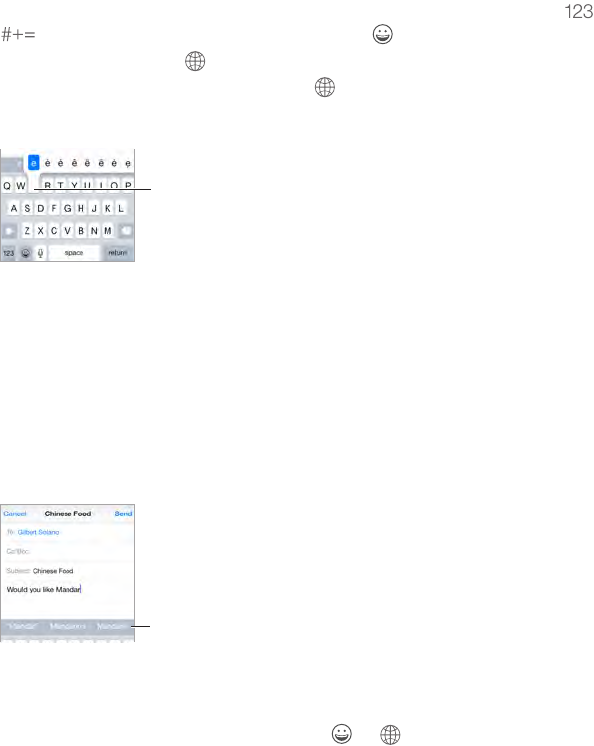
Chapter 3 Basics 25
Tap Shift to type uppercase, or touch the Shift key and slide to a letter. Double-tap Shift for caps
lock. To enter numbers, punctuation, or symbols, tap the Number key or the Symbol key
. If you haven’t added any keyboards, tap to switch to the emoji keyboard. If you have
several keyboards, tap to switch to the last one you used. Continue tapping to access other
enabled keyboards, or touch and hold ,thenslidetochooseadierentkeyboard.Toquickly
end a sentence with a period and a space, just double-tap the space bar.
To type an alternate character,
touch and hold a key, then slide
to choose one of the options.
To type an alternate character,
touch and hold a key, then slide
to choose one of the options.
If you see a word underlined in red, tap it to see suggested corrections. If the word you want
doesn’t appear, type the correction.
As you write, the keyboard predicts your next word (not available in all languages). Tap a word
to choose it, or accept a highlighted prediction by entering a space or punctuation. When you
tap a suggested word, a space appears after the word. If you enter a comma, period, or other
punctuation, the space is deleted. Reject a suggestion by tapping your original word (shown as
the predictive text option with quotation marks).
Predictive text
Predictive text
Hide predictive text. Pull down the suggested words. Drag the bar up when you want to see the
suggestions again.
Turn o predictive text. Touch and hold or , then slide to Predictive.
Ifyouturnopredictivetext,iPodtouchmaystilltrytosuggestcorrectionsformisspelled
words. Accept a correction by entering a space or punctuation, or by tapping return. To reject
a correction, tap the “x.” If you reject the same suggestion a few times, iPod touch stops
suggesting it.
Set options for typing or add keyboards. Go to Settings > General > Keyboard.
You can also use an Apple Wireless Keyboard to enter text. See Use an Apple Wireless
Keyboard on page 26. To dictate instead of typing, see Dictate on page 27.
Apple Confidential
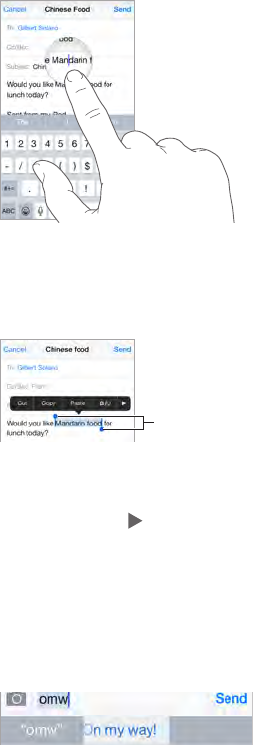
Chapter 3 Basics 26
Edit text
Revise text. Touch and hold the text to show the magnifying glass, then drag to position the
insertion point.
Select text. Tap the insertion point to display the selection options. Or double-tap a word
to select it. Drag the grab points to select more or less text. In read-only documents, such as
webpages, touch and hold to select a word.
Grab points
Grab points
You can cut, copy, or paste over selected text. With some apps, you can also get bold, italic,
orunderlinedtext(tapB/I/U);getthedenitionofaword;orhaveiPodtouchsuggestan
alternative. Tap to see all the options.
Undo the last edit. Shake iPod touch, then tap Undo.
Save keystrokes
A shortcut lets you enter a word or phrase by typing just a few characters. For example, type
“omw” to enter “On my way!” That one’s already set up for you, but you can also add your own.
Create a shortcut. Go to Settings > General > Keyboard, then tap Shortcuts.
Have a word or phrase you use and don’t want it corrected? Create a shortcut, but leave the
Shortcuteldblank.
Use iCloud to keep your personal dictionary up to date on your other devices. Go to Settings >
iCloud, then turn on iCloud Drive or Documents & Data.
Use an Apple Wireless Keyboard
You can use an Apple Wireless Keyboard (available separately) to enter text on your iPod touch.
ThekeyboardconnectsviaBluetooth,soyoumustrstpairitwithiPodtouch.
Note: The Apple Wireless Keyboard may not support keyboard features that are on your device.
For example, it doesn’t anticipate your next word or automatically correct misspelled words.
Pair an Apple Wireless Keyboard with iPod touch. Turn on the keyboard, go to Settings >
Bluetooth and turn on Bluetooth, then tap the keyboard when it appears in the Devices list.
Once it’s paired, the keyboard reconnects to iPod touch whenever it’s in range—up to about 33
feet (10 meters). When it’s connected, the onscreen keyboard doesn’t appear.
Apple Confidential

Chapter 3 Basics 27
Save your batteries. TurnoBluetoothandthewirelesskeyboardwhennotinuse.Youcanturn
oBluetooth inControlCenter.Toturnothekeyboard,holddowntheOn/oswitchuntilthe
greenlightgoeso.
Unpair a wireless keyboard. Go to Settings > Bluetooth, tap next to the keyboard name, then
tap Forget this Device.
See Bluetooth devices on page 36.
Add or change keyboards
Youcanturntypingfeatures,suchasspellchecking,onoro;addkeyboardsforwritingin
dierentlanguages;andchangethelayoutofyouronscreenkeyboardorAppleWireless
Keyboard.
Set typing features. Go to Settings > General > Keyboard.
Add a keyboard for another language. Go to Settings > General > Keyboard > Keyboards > Add
New Keyboard.
Switch keyboards. If you haven’t added any keyboards, tap to switch to the emoji keyboard.
If you have several keyboards, tap to switch to the last one you used. Continue tapping to
access other enabled keyboards, or touch and hold ,thenslidetochooseadierentkeyboard.
For information about international keyboards, see Use international keyboards on page 147.
Change the keyboard layout. Go to Settings > General > Keyboard > Keyboards, select a
keyboard, then choose a layout.
Dictate
If you like, you can dictate instead of typing on iPod touch. Make sure Enable Dictation is turned
on (in Settings > General > Keyboard) and iPod touch is connected to the Internet.
Note: Dictation may not be available in all languages or in all areas, and features may vary.
Dictate text. Tap ontheonscreenkeyboard,thenspeak.TapDonewhenyounish.
Tap to begin dictation.
Tap to begin dictation.
Add text. Tap againandcontinuedictating.Toinserttext,taptoplacetheinsertionpointrst.
You can also replace selected text by dictating.
Add punctuation or format text. Say the punctuation or format. For example, “Dear Mary
comma the check is in the mail exclamation mark” becomes “Dear Mary, the check is in the mail!”
Punctuation and formatting commands include:
•quote … end quote
•new paragraph
•new line
Apple Confidential
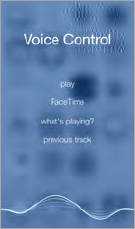
Chapter 3 Basics 28
•cap—to capitalize the next word
•capson…capso—tocapitalizetherstcharacterofeachword
•all caps—to make the next word all uppercase
•allcapson…allcapso—tomaketheenclosedwordsalluppercase
•nocapson…nocapso—tomaketheenclosedwordsalllowercase
•nospaceon…nospaceo—torunaseriesofwordstogether
•smiley—to insert :-)
•frowny—to insert :-(
•winky—to insert ;-)
Voice Control
Make FaceTime calls and control music playback with Voice Control. (You can also use Siri to
control iPod touch by voice. See Chapter 4, Siri, on page 41.)
Note: Voice Control and Voice Control settings aren’t available when Siri is turned on.
Use Voice Control. TurnSirioinSettings>General>Siri.ThenpressandholdtheHomebutton
until the Voice Control screen appears and you hear a beep.
For best results:
•Speak clearly and naturally.
•Say only Voice Control commands, names, and numbers. Pause slightly between commands.
•Use full names.
Change the language for Voice Control. By default, Voice Control expects you to speak voice
commands in the language that’s set for iPod touch (in Settings > General > International >
Language). To use Voice Control in another language or dialect, go to Settings > General >
International > Voice Control.
Voice Control for the Music app is always on, but you can keep Voice Control from dialing
FaceTimecallswheniPodtouchislocked.GotoSettings>Passcode,thenturnoVoiceDial.
Forspeciccommands,seeSiri and Voice Control on page 61. For more about using
VoiceControl,includinginformationaboutusingVoiceControlindierentlanguages,see
support.apple.com/kb/HT3597.
Apple Confidential

Chapter 3 Basics 29
Search
Search apps
Manyappsincludeasearcheldwhereyoucantypetondsomethingwithintheapp.For
example,intheMapsapp,youcansearchforaspeciclocation.
Spotlight Search
Spotlight Search not only searches your iPod touch, but also shows suggestions from the
App Store and the Internet. You may see suggestions for movie showtimes, nearby locations,
and more.
Search iPod touch. DragdownthemiddleofanyHomescreentorevealthesearcheld.Results
occur as you type; to hide the keyboard and see more results on the screen, tap Search. Tap an
item in the list to open it.
YoucanalsouseSpotlightSearchtondandopenapps.
Choose which apps and content are searched. Go to Settings > General > Spotlight Search,
then tap to deselect apps or content. To change the search order, touch and drag to a
new position.
Limit Spotlight Search to your iPod touch. Go to Settings > General > Spotlight Search, then tap
Spotlight Suggestions to deselect it.
Turn o Location Services for Spotlight Suggestions. Go to Settings > Privacy > Location
Services.TapSystemServices,thenturnoSpotlightSuggestions.
Use Siri.Say something like:
•“Find pictures of killer whales”
•“Search the web for vegetarian pasta recipes”
•"Search the web for polar bears”
Apple Confidential

Chapter 3 Basics 30
Control Center
Control Center gives you instant access to the camera, calculator, AirPlay, control and playback
of currently playing audio, and other handy features. You can also adjust the brightness, lock
thescreeninportraitorientation,turnwirelessservicesonoro,andturnonAirDrop.See
AirDrop on page 32.
Models with
iSight camera
Models with
iSight camera
Open Control Center. Swipe up from the bottom edge of any screen (even the Lock screen).
Open the currently playing audio app. Tap the song title.
Close Control Center. Swipe down, tap the top of the screen, or press the Home button.
Turn o access to Control Center in apps or on the Lock screen. Go to Settings > Control Center.
Alerts and Notication Center
Alerts
Alertsletyouknowaboutimportantevents.Theycanappearbrieyatthetopofthescreen,or
remain in the center of the screen until you acknowledge them.
Some apps may include a badge on their Home screen icon, to let you know how many new
items await—for example, the number of new email messages. If there’s a problem—such as a
message that couldn’t be sent—an exclamation mark appears on the badge. On a folder, a
numberedbadgeindicatesthetotalnumberofnoticationsforalltheappsinside.
Alerts can also appear on the Lock screen.
Respond to an alert without leaving your current app. Pull down on the alert when it appears
at the top of your screen.
Note: This feature works with text and email messages, calendar invitations, and more.
Respond to an alert when iPod touch is locked. Swipe the alert from right to left.
Silence your alerts. Go to Settings > Do Not Disturb.
Set sounds. Go to Settings > Sounds.
Notication Center
NoticationCentercollectsyournoticationsinoneplace,soyoucanreviewthemwhenever
you’re ready. View details about your day—such as the weather forecast, appointments,
birthdays, stock quotes, and even a quick summary of what’s coming up tomorrow. Tap the
Noticationstabtoreviewallyouralerts.
Apple Confidential

Chapter 3 Basics 31
Open Notication Center. Swipe down from the top edge of the screen.
Set Today options. To choose what information appears, tap the Edit key at the end of your
information on the Today tab. Tap + or — to add or remove information. To arrange the order of
your information, touch , then drag it to a new position.
Set notication options. GotoSettings>Notications.Tapanapptosetitsnoticationoptions.
Forexample,choosetoviewanoticationfromtheLockscreen.YoucanalsotapEdittoarrange
theorderofappnotications.Touch , then drag it to a new position.
Choose whether to show Today and Notications View on a locked screen. Go to Settings >
Passcode, then choose whether to allow access when locked.
Close Notication Center. Swipe up, or press the Home button.
Sounds and silence
YoucanchangeorturnothesoundsiPodtouchplayswhenyougetaFaceTimecall,text,email,
tweet, Facebook post, reminder, or other event.
Set sound options. Go to Settings > Sounds for options such as alert tones and ringtones, and
ringer and alert volumes.
IfyouwanttotemporarilysilenceincomingFaceTimecalls,alerts,andsoundeects,seethe
following section.
Do Not Disturb
Do Not Disturb is an easy way to silence iPod touch, whether you’re going to dinner or to sleep.
It keeps FaceTime calls and alerts from making any sounds or lighting up the screen.
Turn on Do Not Disturb. Swipe up from the bottom edge of the screen to open Control Center,
then tap . When Do Not Disturb is on, appears in the status bar.
Note: Alarms still sound, even when Do Not Disturb is on. To make sure iPod touch stays silent,
turnito.
Congure Do Not Disturb. Go to Settings > Do Not Disturb.
You can schedule quiet hours, allow FaceTime calls from your Favorites or groups of contacts, and
allow repeated calls to ring through for those emergency situations. You can also set whether Do
Not Disturb silences iPod touch only when it’s locked, or even when it’s unlocked.
Apple Confidential

Chapter 3 Basics 32
Sharing
Share from apps
In many apps, you can tap Share or to choose how to share your information. The choices vary
depending on the app you’re using. Additional options may appear if you’ve downloaded apps
with sharing options. For more information, see App extensions on page 21.
Use Twitter, Facebook, Flickr, Vimeo or other third-party apps with sharing options. Sign in to
your account in Settings. The third-party sharing buttons take you to the appropriate setting if
you’re not yet signed in.
Customize the dierent ways you share, view, and organize your information. Tap the More
button, then touch and drag to move items to new positions.
AirDrop
AirDrop lets you share your photos, videos, websites, locations, and other items wirelessly
with other nearby devices (iOS 7 or later). With iOS 8, you can share with Mac computers with
OS X Yosemite. AirDrop transfers information using Wi-Fi and Bluetooth—both must be turned
on. To use AirDrop, you need to be signed into iCloud using your Apple ID, and must be on the
same Wi-Fi network, or within approximately 33 feet (10 meters) of the other device. Transfers are
encrypted for security.
Tap to share with
a nearby friend
using AirDrop.
Tap to share with
a nearby friend
using AirDrop.
Share an item using AirDrop. Tap Share , then tap the name of a nearby AirDrop user.
Receive AirDrop items from others. Swipe up from the bottom edge of the screen to open
Control Center. Tap AirDrop, then choose to receive items from Contacts Only or from Everyone.
You can accept or decline each request as it arrives.
Family Sharing
With Family Sharing, up to six family members can share their iTunes Store, App Store, and
iBooks Store purchases, a family calendar, and family photos, all without sharing accounts.
Apple Confidential
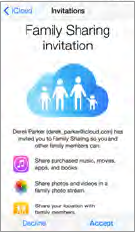
Chapter 3 Basics 33
One adult in your household—the family organizer—invites family members to join the family
group and agrees to pay for any iTunes Store, App Store, and iBooks Store purchases those family
members initiate while part of the family group. Once set up, family members get immediate
access to each other’s music, movies, TV shows, books, and eligible apps. In addition, family
members can easily share photos in a shared family album, add events to a family calendar,
share their location with other family members, and even help locate another family member’s
missing device.
Children under 13 can participate in Family Sharing, too. As a parent or legal guardian, the family
organizer can provide parental consent for a child to have his or her own Apple ID, and create it
on the child’s behalf. Once the account is created, it’s added to the family group automatically.
Family Sharing requires you to sign in to iCloud with your Apple ID. You will also be asked to
conrmtheAppleIDyouusefortheiTunesStore,AppStore,andiBooksStore.Itisavailableon
devices with iOS 8, Mac computers with OS X Yosemite, and PCs with iCloud for Windows 4.0. You
can be part of only one family group at a time.
Set up Family Sharing. Go to Settings > iCloud > Set Up Family Sharing. Follow the onscreen
instructions to set up Family Sharing as the family organizer, then invite family members to join.
Create an Apple ID for a child. Go to Settings > iCloud > Family, scroll to the bottom of the
screen, then tap Create an Apple ID for a child.
Accept an invitation to Family Sharing. Make sure you are signed into iCloud, and that you can
accept a Family Sharing invitation from your iOS device (iOS 8 required), Mac (OS X Yosemite
required), or PC (iCloud for Windows 4.0 required). Or, if the organizer is nearby during the setup
process, he or she can simply ask you to enter the Apple ID and password you use for iCloud.
Access shared iTunes Store, App Store, and iBooks Store purchases. Open iTunes Store, iBooks
Store, or App Store, tap Purchased, then choose a family member from the menu that appears.
When a family member initiates a purchase, it is billed directly to the family organizer’s account.
Once purchased, the item is added to the initiating family member’s account and is shared with
the rest of the family. If Family Sharing is ever disabled, each person keeps the items they chose
to purchase—even if they were paid for by the family organizer.
Turn on Ask to Buy. The family organizer can require young family members to request approval
for purchases or free downloads. Go to Settings > iCloud > Family, then tap the person’s name.
Note: Age restrictions for Ask to Buy vary by area. In the United States, the family organizer can
enable Ask to Buy for any family member under age 18; for children under age 13, it’s enabled
by default.
Apple Confidential

Chapter 3 Basics 34
Hide your iTunes Store, App Store, and iBooks Store purchases. Open iTunes on your computer,
then click iTunes Store. Under Quick Links, click Purchased, then choose the content type
(for example, Music or Movies). Hover over the item you want to hide, then click . To make
purchases visible again, return to Quick Links, then click Account. Scroll down to iTunes in the
Cloud, then click Manage (to the right of Hidden Purchases).
Share photos or videos with family members. When you set up Family Sharing, a shared album
called “Family” is automatically created in the Photos app on all family members’ devices. To share
a photo or video with family members, open the Photos app, then view a photo or video or
select multiple photos or videos. Tap , tap iCloud Photo Sharing, add comments, then share to
your shared family album. See iCloud Photo Sharing on page 73.
Add an event to the family calendar. When you set up Family Sharing, a shared calendar called
“Family” is automatically created in the Calendar app on all family members’ devices. To add a
family event, open the Calendar app, create an event, then choose to add the event to the family
calendar. See Share iCloud calendars on page 69.
Set up a family reminder. When you set up Family Sharing, a shared list is automatically created
in the Reminders app on all family members’ devices. To add a reminder to the family list, open
the Reminders app, tap the family list, then add a reminder to the list. See Reminders at a
glance on page 93.
Share your location with family members. Family members can share their location by tapping
Settings>iCloud>ShareMyLocation(underAdvanced).Tondafamilymember’slocation,
use the Find My Friends app (download it for free from the App Store). Or use the Messages
app (iOS 8 required). For more information about using Messages to share or view locations, see
Share photos, videos, your location, and more on page 45.
Keep track of your family’s devices. If family members have enabled Share My Location in
iCloud, you can help them locate missing devices. Open Find My iPhone on your device or at
iCloud.com. For more information, see Find My iPod touch on page 39.
Leave Family Sharing. Go to Settings > iCloud > Family, then tap Leave Family Sharing. If you are
the organizer, go to Settings > iCloud > Family, tap your name, then tap Stop Family Sharing. For
more information, see support.apple.com/kb/HT201081.
iCloud Drive
About iCloud Drive
iCloud Drive stores your presentations, spreadsheets, PDFs, images, and other kinds of
documents in iCloud so you can access these documents from any of your devices set up
withiCloud.Itallowsyourappstosharedocumentssoyoucanworkonthesameleacross
multiple apps.
iCloud Drive works with devices with iOS 8, Mac computers with OS X Yosemite, PCs with iCloud
for Windows 4.0, or through iCloud.com. To access iCloud Drive, you must be signed into iCloud
using your Apple ID. iCloud Drive works with supported apps including Pages, Numbers, Keynote,
GarageBand, and some third-party apps.
Apple Confidential

Chapter 3 Basics 35
Set up iCloud Drive
You can set up iCloud Drive using Setup Assistant when you install iOS 8, or you can set it up
later in Settings. iCloud Drive is an upgrade to Documents & Data. When you upgrade to iCloud
Drive, your documents are copied to iCloud Drive and become available on your devices using
iCloud Drive. You won’t be able to access the documents stored in iCloud Drive on your other
devices until they are also upgraded to iOS 8 or OS X Yosemite. For more information about
upgrading to iCloud Drive, see support.apple.com/kb/HT6345.
Set up iCloud Drive. Go to Settings > iCloud > iCloud Drive, then turn on iCloud Drive and follow
the onscreen instructions.
Transfer les
ThereareseveralwaystotransferlesbetweenyouriPodtouchandyourcomputerorother
iOS device.
Transfer les using iTunes. Connect iPod touch to your computer using the included cable.
In iTunes on your computer, select iPod touch, then click Apps. Use the File Sharing section to
transferdocumentsbetweeniPodtouchandyourcomputer.Appsthatsupportlesharing
appearintheFileSharingAppslistiniTunes.Todeleteale,selectitintheDocumentslist,then
press the Delete key.
YoucanalsoviewlesreceivedasemailattachmentsoniPodtouch.
Withsomeapps,youcantransferlesusingAirDrop.SeeAirDrop on page 32.
AirPlay
Use AirPlay to stream music, photos, and video wirelessly to Apple TV and other AirPlay-enabled
devices. If you don’t see your AirPlay-enabled devices when you tap , you may also need to
make sure everything is on the same Wi-Fi network.
Display the AirPlay controls. Swipe up from the bottom edge of the screen to open Control
Center, then tap .
Stream content. Tap , then choose the device you want to stream to.
Switch back to iPod touch. Tap , then choose iPod touch.
Mirror the iPod touch screen on a TV. Tap , choose an Apple TV, then tap Mirroring. A blue bar
appears at the top of the iPod touch screen when AirPlay mirroring is turned on.
You can also connect iPod touch to a TV, projector, or other external display using the
appropriate Apple cable or adapter. See support.apple.com/kb/HT4108.
AirPrint
Use AirPrint to print wirelessly to an AirPrint-enabled printer from apps such as Mail, Photos, and
Safari. Many apps available on the App Store also support AirPrint.
iPod touch and the printer must be on the same Wi-Fi network. For more information about
AirPrint, see support.apple.com/kb/HT4356.
Print a document. Tap or (depending on the app you’re using).
See the status of a print job. Double-click the Home button, then tap Print Center. The badge on
the icon shows how many documents are in the queue.
Apple Confidential

Chapter 3 Basics 36
Cancel a job. Select it in Print Center, then tap Cancel Printing.
Bluetooth devices
You can use Bluetooth devices with iPod touch, such as stereo headphones or an Apple Wireless
Keyboard.ForsupportedBluetoothproles,gotosupport.apple.com/kb/HT3647.
WARNING: For important information about avoiding hearing loss and avoiding distractions
that could lead to dangerous situations, see Important safety information on page 150.
Note: TheuseofcertainaccessorieswithiPodtouchmayaectwirelessperformance.Notall
iPhone and iPad accessories are fully compatible with iPod touch. Turning on airplane mode may
eliminate audio interference between iPod touch and an accessory. Reorienting or relocating
iPod touch and the connected accessory may improve wireless performance.
Turn on Bluetooth. Go to Settings > Bluetooth.
Connect to a Bluetooth device. Tap the device in the Devices list, then follow the onscreen
instructions to connect to it. See the documentation that came with the device for information
about Bluetooth pairing. For information about using an Apple Wireless Keyboard, see Use an
Apple Wireless Keyboard on page 26.
iPod touch must be within about 33 feet (10 meters) of the Bluetooth device.
Return audio output to iPod touch. Turnoorunpairthedevice,turnoBluetoothinSettings>
Bluetooth, or use AirPlay to switch audio output to iPod touch. See AirPlay on page 35. Audio
output returns to iPod touch whenever the Bluetooth device is out of range.
Unpair a device. In Settings > Bluetooth, tap next to the device, then tap Forget this Device. If
you don’t see the Devices list, make sure Bluetooth is on.
Restrictions
You can set restrictions for some apps, and for purchased content. For example, parents can
restrict explicit music from appearing in playlists, or disallow changes to certain settings. Use
restrictions to prevent the use of certain apps, the installation of new apps, or changes to
accounts or the volume limit.
Turn on restrictions. Go to Settings > General > Restrictions, then tap Enable Restrictions. You’ll
beaskedtodenearestrictionspasscodethat’snecessarytochangethesettingsyoumake.This
canbedierentthanthepasscodeforunlockingiPodtouch.
Important: If you forget your restrictions passcode, you must restore the iPod touch software.
See Restore iPod touch on page 157.
Privacy
Privacy settings let you see and control which apps and system services have access to Location
Services, and to contacts, calendars, reminders, and photos.
Location Services lets location-based apps such as Maps, Camera, and Passbook gather and
use data indicating your location. Your approximate location is determined using available
information from local Wi-Fi networks (if you have Wi-Fi turned on). The location data collected
byAppleisn’tcollectedinaformthatpersonallyidentiesyou.WhenanappisusingLocation
Services, appears in the status bar.
Apple Confidential

Chapter 3 Basics 37
Turn Location Services on or o. GotoSettings>Privacy>LocationServices.Youcanturnito
forsomeorforallappsandservices.IfyouturnoLocationServices,you’repromptedtoturnit
on again the next time an app or service tries to use it.
Turn Location Services o for system services. Several system services, such as location-based
ads,useLocationServices.Toseetheirstatus,turnthemonoro,orshow in the menu
bar when these services use your location, go to Settings > Privacy > Location Services >
System Services.
Turn o access to private information. Go to Settings > Privacy. You can see which apps and
features have requested and been granted access to the following information:
•Contacts
•Calendars
•Reminders
•Photos
•Bluetooth Sharing
•Microphone
•Camera
•Health
•HomeKit
•Twitter
•Facebook
Youcanturnoeachapp’saccesstoeachcategoryofinformation.Reviewthetermsandprivacy
policy for each third-party app to understand how it uses the data it’s requesting. For more
information, see support.apple.com/kb/HT6338.
Security
Security features help protect the information on your iPod touch from being accessed by others.
Use a passcode with data protection
For better security, you can set a passcode that must be entered each time you turn on or wake
up iPod touch.
Set a passcode. Go to Settings > Passcode, then set a 4-digit passcode.
Setting a passcode turns on data protection, using your passcode as a key to encrypt Mail
messages and attachments stored on iPod touch, using 256-bit AES encryption. (Other apps may
also use data protection.)
Increase security. TurnoSimplePasscodeandusealongerpasscode.Toenterapasscodethat’s
a combination of numbers and letters, you use the keyboard. If you prefer to unlock iPod touch
using the numeric keypad, set up a longer passcode using numbers only.
Allow access to features when iPod touch is locked. Go to Settings > Passcode. Optional
features include:
•Today (see NoticationCenter on page 30)
•NoticationsView(seeNoticationCenter on page 30)
•Siri (if enabled; see Siri settings on page 42)
•Passbook (see Chapter 26, Passbook, on page 112)
Apple Confidential
Chapter 3 Basics 38
•Reply with Message (see Make and answer calls on page 65)
Allow access to Control Center when iPod touch is locked. Go to Settings > Control Center. See
Control Center on page 30.
Erase data after ten failed passcode attempts. Go to Settings > Passcode, then tap Erase Data.
After ten failed passcode attempts, all settings are reset, and all your information and media are
erased by removing the encryption key to the data.
If you forget your passcode, you must restore the iPod touch software. See Restore iPod touch on
page 157.
iCloud Keychain
iCloud Keychain keeps your Safari website user names and passwords, credit card information,
and Wi-Fi network information up to date. iCloud Keychain works on all your approved devices
(iOS 7 or later) and Mac computers (OS X Mavericks or later).
iCloud Keychain works with Safari Password Generator and AutoFill. When you’re setting up a
new account, Safari Password Generator suggests unique, hard-to-guess passwords. You can use
AutoFill to have iPod touch enter your user name and password info, making login easy. See Fill
in forms on page 56.
Note: Some websites do not support AutoFill.
iCloud Keychain is secured with 256-bit AES encryption during storage and transmission, and
cannot be read by Apple.
Set up iCloud Keychain. Go to Settings > iCloud > Keychain. Turn on iCloud Keychain, then
follow the onscreen instructions. If you set up iCloud Keychain on other devices, you need to
approve the use of iCloud Keychain from one of those devices, or use your iCloud Security Code.
Important: If you forget your security code, you have to start over and set up your iCloud
Keychain again.
Set up AutoFill. Go to Settings > Safari > Passwords & AutoFill. Make sure Names and Passwords,
and Credit Cards, are turned on (they’re on by default). To add credit card info, tap Saved
Credit Cards.
The security code for your credit card is not saved—you have to enter that manually.
Toautomaticallyllinnames,passwords,orcreditcardinfoonsitesthatsupportit,tapatext
eld,thentapAutoFill.
To protect your personal information, set a passcode if you turn on iCloud Keychain and AutoFill.
Limit Ad Tracking
Restrict or reset Ad Tracking. Go to Settings > Privacy > Advertising. Turn on Limit Ad Tracking
topreventappsfromaccessingyouriPodtouchadvertisingidentier.Formoreinformation,tap
About Advertising & Privacy.
Apple Confidential

Chapter 3 Basics 39
Find My iPod touch
Find My iPod touch can help you locate and secure your iPod touch using the free Find My
iPhone app (available in the App Store) on another iPod touch, iPhone, or iPad, or using a Mac or
PC web browser signed into www.icloud.com/nd. Find My iPod touch includes Activation Lock,
which is designed to prevent anyone else from using your iPod touch if you ever lose it. Your
AppleIDandpasswordarerequiredtoturnoFindMyiPodtouch,ortoeraseandreactivate
your iPod touch.
Turn on Find My iPod touch. Go to Settings > iCloud > Find My iPod touch.
Important: To use these features, Find My iPod touch must be turned on before your iPod touch
is lost. iPod touch must be able to connect to the Internet for you to locate and secure
the device.
Use Find My iPhone. Open the Find My iPhone app on an iOS device, or go to
www.icloud.com/nd on your computer. Sign in, then select your device.
•Play Sound: Play a sound at full volume for two minutes, even if the ringer is set to silent.
•Lost Mode: Immediately lock your missing iPod touch with a passcode and send it a message
displaying a contact number. iPod touch also tracks and reports its location, so you can see
where it’s been when you check the Find My iPhone app.
•Erase iPod touch: Protect your privacy by erasing all the information and media on your
iPod touch and restoring it to its original factory settings.
Note: Before selling or giving away your iPod touch, you should erase it completely to remove all
yourpersonaldata,andturnoFindMyiPodtouchtoensurethenextownercanactivateand
use the device normally. Go to Settings > General > Reset > Erase All Content and Settings. See
Sell or give away iPod touch on page 157.
Charge and monitor the battery
iPod touch has an internal, lithium-ion rechargeable battery. For more information about the
battery—including tips for maximizing battery life—see www.apple.com/batteries.
WARNING: For important safety information about the battery and charging iPod touch, see
Important safety information on page 150.
Charge the battery. Connect iPod touch to your computer using the included cable. You can
sync iPod touch with iTunes at the same time. It may take longer to charge, however, if you sync
or use iPod touch while it is charging.
Unless your keyboard has a high-power USB 2.0 or 3.0 port, you must connect iPod touch to a
USB 2.0 or 3.0 port on your computer.
Apple Confidential

Chapter 3 Basics 40
Important: The iPod touch battery may drain instead of charge if iPod touch is connected to a
computerthat’sturnedoorisinsleeporstandbymode.
Charge the battery using a power adapter. Connect iPod touch to a power outlet using the
included cable and a USB power adapter (available separately).
Note: Connecting iPod touch to a power outlet can start an iCloud backup or wireless iTunes
syncing. See Back up iPod touch on page 156 and Sync with iTunes on page 16.
The battery icon in the upper-right corner shows the battery level or charging status.
Important: If iPod touch is very low on power, it may display an image of a nearly depleted
battery, indicating that iPod touch needs to charge for up to ten minutes before you can use it.
If iPod touch is extremely low on power, the display may be blank for up to two minutes before
one of the low-battery images appears.
Rechargeable batteries have a limited number of charge cycles and may eventually need to
be replaced. The iPod touch battery isn’t user replaceable; it can be replaced only by an Apple
Authorized Service Provider. See www.apple.com/batteries/replacement-and-recycling.html.
Travel with iPod touch
Some airlines let you keep your iPod touch turned on if you switch to Airplane Mode. Wi-Fi and
Bluetooth are disabled so you can’t make or receive FaceTime calls or use features that require
wireless communication, but you can listen to music, play games, watch videos, or use other
apps that don’t require Internet access. If the airline allows it, you can turn Wi-Fi or Bluetooth
back on to enable those services, even while in Airplane Mode.
Turn on Airplane Mode. Swipe up from the bottom edge of the screen to open Control Center,
then tap .YoucanalsoturnAirplaneModeonoroinSettings.Whenairplanemodeison,
appears in the status bar at the top of the screen.
YoucanalsoturnWi-FiandBluetoothonoroinControlCenter.
Apple Confidential

4
41
Make requests
Siri lets you speak to iPod touch to send messages, schedule meetings, make FaceTime calls,
and much more. Siri understands natural speech, so you don’t have to learn special commands
or keywords. Ask Siri anything, from “set the timer for 3 minutes” to “what movies are showing
tonight?” Open apps, and turn features like Airplane Mode, Bluetooth, Do Not Disturb, and
VoiceOveronoro.Siriisgreatforkeepingyouupdatedwiththelatestsportsinfo,helpingyou
decide on a restaurant, and searching the iTunes Store or App Store for purchases.
Note: To use Siri, iPod touch must be connected to the Internet. See Connect to the Internet on
page 14.
Summon Siri. Press and hold the Home button until Siri beeps, then make your request.
Control when Siri listens. Instead of letting Siri notice when you stop talking, you can continue
toholddowntheHomebuttonwhileyouspeak,andreleaseitwhenyounish.
Hey Siri. With iPod touch connected to a power source (or if you’ve already started a
conversation with Siri), you can use Siri without even pressing the Home button. Just say “Hey
Siri,”thenmakeyourrequest.ToturnHeySirionoro,gotoSettings>General>Siri>Allow
“Hey Siri”.
If you’re using a headset, you can use the center or call button in place of the Home button.
Tap to speak to Siri.
Tap to speak to Siri.
Response from Siri
Response from Siri
Often you can
tap the screen
for additional info
or further action.
Often you can
tap the screen
for additional info
or further action.
For hints, ask Siri “what can you do,” or tap .
Depending on your request, the onscreen response from Siri often includes information or
images that you can tap for additional detail, or to perform some other action like searching the
web or opening a related app.
Change the voice gender for Siri. Go to Settings > General > Siri (may not be available in all
areas).
Siri
Apple Confidential

Chapter 4 Siri 42
Adjust the volume for Siri. Use the volume buttons while you’re interacting with Siri.
Siri and apps
Siri works with many of the apps on iPod touch, including FaceTime, Messages, Maps, Clock,
Calendar, and more. For example, you can say things like:
•“FaceTime Mom”
•“Do I have any new texts from Rick?”
•“I’m running low on gas”
•“Set an alarm for 8 a.m.”
•“Cancel all my meetings on Friday”
More examples of how you can use Siri with apps appear throughout this guide.
Tell Siri about yourself
If you tell Siri about yourself—including things like your home and work addresses, and
your relationships—you can get personalized service like, “remind me to call my wife” or “get
directions to home.”
Tell Siri who you are. Fill out your info card in Contacts, then go to Settings > General > Siri > My
Info and tap your name.
To let Siri know about a relationship, say something like “Emily Parker is my wife.”
Note: Siri uses Location Services when your requests require knowing your location. See
Privacy on page 36.
Make corrections
If Siri doesn’t get something right, you can tap to edit your request.
Or tap again, then clarify your request verbally.
Want to cancel that last command? Say “cancel,” tap the Siri icon, or press the Home button.
Siri settings
To set options for Siri, go to Settings > General > Siri. Options include:
•TurningSirionoro
•TurningAllow“HeySiri”onoro
•Language
•Voice gender (may not be available in all areas)
•Voice feedback
•My Info card
Prevent access to Siri when iPod touch is locked. Go to Settings > Passcode. You can also
disable Siri by turning on restrictions. See Restrictions on page 36.
Apple Confidential
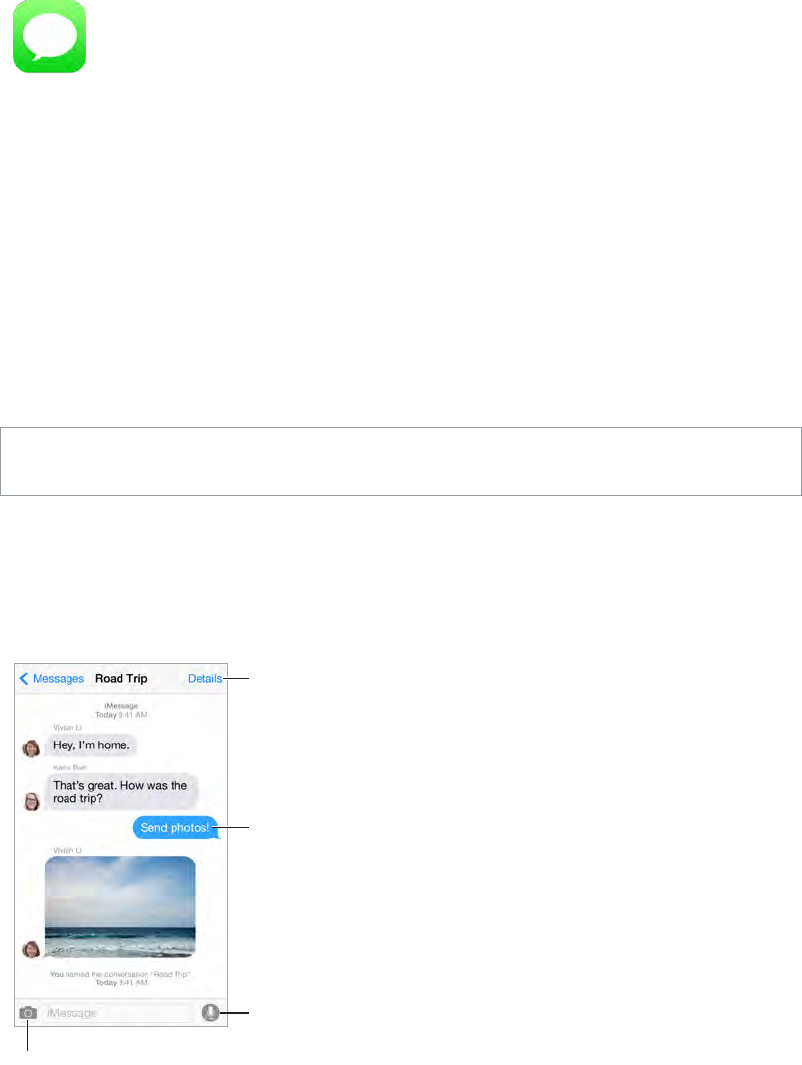
5
43
iMessage service
With the Messages app and the built-in iMessage feature, you can send text messages over
Wi-Fi to others using iOS 5 or later, or OS X Mountain Lion or later. Messages can include photos,
videos, and other info. You can see when people are typing, and let them know when you’ve
read their messages. If you’re signed into iMessage using the same Apple ID on other iOS devices
or a Mac (OS X Mavericks or later), you can start a conversation on one device and continue it on
another. For security, messages you send with iMessage are encrypted before they’re sent.
If your iPhone (iOS 8) is signed into iMessage using the same Apple ID, you can also send and
receive SMS and MMS messages on your iPod touch. Charges may apply to the text messaging
service for your iPhone.
WARNING: For important information about avoiding distractions that could lead to dangerous
situations, see Important safety information on page 150.
Note: Cellular data charges or additional fees may apply for iPhone and iPad users you exchange
messages with over their cellular data network.
Send and receive messages
Send a photo or video.
Send a photo or video.
Add your voice to
the conversation.
Add your voice to
the conversation.
Get info, make a
voice or FaceTime
call, share your
location, or mute
notifications.
Get info, make a
voice or FaceTime
call, share your
location, or mute
notifications.
Blue indicates
an iMessage
conversation.
Blue indicates
an iMessage
conversation.
Messages
Apple Confidential